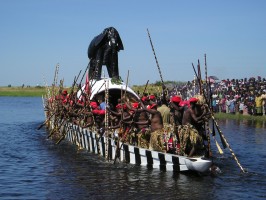- Home
- About Zambia
About Zambia
Introduction
Zambia, officially the Republic of Zambia, is a landlocked country in Southern Africa. The neighbouring countries are the Democratic Republic of the Congo to the north, Tanzania to the north-east, Malawi to the east, Mozambique, Zimbabwe, Botswana and Namibia to the south, and Angola to the west. The capital city is Lusaka, located in the south-central part of the country. The population is concentrated mainly around Lusaka in the south and the Copperbelt Province to the northwest.
History
From 1953 to 1964, Northern Rhodesia was federated with Southern Rhodesia (now Zimbabwe) and Nyasaland (now Malawi) in the Federation of Rhodesia and Nyasaland.
The region was ruled by the British South Africa Company, which Rhodes established, until 1924, when the British government took over the administration.
On 24 October 1964, the country became independent of the United Kingdom and then-prime minister Kenneth Kaunda became the inaugural president. Kaunda's socialist United National Independence Party (UNIP) maintained power from the 1964 until 1991.
Natural Resources
Apart from its abundant wildlife, rivers, and lakes, Zambia holds 6% of the worlds copper reserves and is the fourth largest copper producing nation in the world. Zambia is internationally recognised as a major producer of emeralds, aquamarines, amethyst and tourmalines and the quality of the gems are highly competitive with world markets.
Zambia is known as the undiscovered gem of Africa, and a safari in this vast country offers huge diversity: an exploration of a land filled with waterfalls, lakes, rivers and wetlands, and the discovery of a country proud of its’ culture and traditions, abundant wildlife and exotic wilderness. Zambia boasts 19 national game parks, including the Kafue National Park, Africa’s largest game reserve, and the South Luangwa, known as one of Africa’s premier wildlife destinations. Zambia and Zimbabwe’s borders meet at one of the natural wonders of the world, the Victoria Falls, and one of the largest man-made lakes, Lake Kariba.
Tradition and Culture
Zambia’s contemporary culture is a blend of values, norms, material and spiritual traditions of more than 70 ethnically diverse people. Most of the tribes of Zambia moved into the area in a series of migratory waves a few centuries ago. They grew in numbers and many travelled in search of establishing new kingdoms, farming land and pastures.
During the colonial period, the process of industrialisation and urbanisation saw ethnically different people brought together by economic interests. This, as well as the very definite influence of western standards, generated a new culture without conscious effort of politically determined guidelines.
Many of the rural inhabitants however, have retained their indigenous and traditional customs and values. After Independence in 1964, the government recognised the role culture was to play in the overall development of a new nation and began to explore the question of a National identity.







